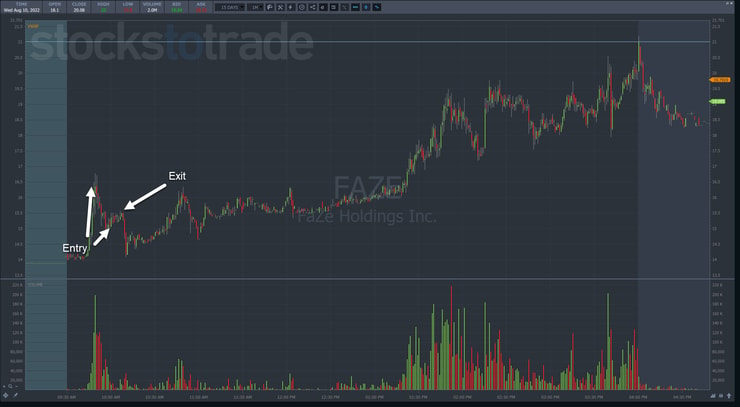Every day, I get traders who sign up for my millionaire challenge.
Many of them come to me after years of struggling to turn a profit.
A long time ago, that was me. I studied every area of the market, scouring charts and setups to find the ‘perfect’ system.
That’s when I stumbled across penny stocks.
At first, I was so excited to turn a profit I lumped all cheap stocks together.
It wasn’t until later that I realized over-the-counter (OTC) stocks were my real jam.
This became my comfort zone and the foundation for my teaching.
Don’t get me wrong, there are plenty of other consistently profitable strategies out there. Mark Croock is a great example of someone who applied my teachings to become an excellent options trader.
But my strategy works best with OTC stocks.
What is it about these stocks that make them so unique?
More importantly, why does my strategy work better with OTC stocks than other penny stocks?
The answers to these questions will help you pinpoint the best stocks for your strategy and maximize profitability.
Table of Contents
Measuring The Difference

2025 Millionaire Media, LLCFirst things first. Let’s discuss how the plumbing behind these markets work.
Most of us are familiar with the typical exchange like the Nasdaq or NYSE.
Whenever I buy or sell a stock, it’s either routed to a market maker or directly to the floor.
Market makers are like stock warehouses. They hold shares in inventory which they use to fill your order.
They manage their inventory based on risk, aiming to make money through the spread between the bid and the ask.
Any stock listed on one of the main exchanges needs to meet various reporting, revenue, and structural requirements.
OTC markets have much lower listing requirements including market capitalization size, revenues, and the like.
Issuers who list on the OTC markets are divided into three categories: OTCQX, OTCQB, and OTC Pink, with OTC Pink being the riskiest.
Unlike the Nasdaq stocks which trade on a central exchange, OTC stocks trade through a broker-dealer network. This means there is no physical location or market maker.
Generally speaking, the floats and volumes on OTC stocks are much lower than regular stocks.
From an investment standpoint, OTC stocks are very risky.
From a trading standpoint, they offer opportunities you won’t find on the regular exchanges.
Price Action Comparison
I want to show you a FaZe Holdings Inc. chart (NASDAQ: FAZE). This is a look at a day when I tried and failed to take a long position in the stock.
This one-minute chart shows an incredible amount of chop as the stock ground its way higher.
Right now, my favorite way to step into trades is with a dip buy.
Once I enter a stock, I immediately cut my position if it trades sideways or lower.
I want to see runners.
The problem is with regular stocks, there is a lot more chop, especially ones with large floats.
Compare that to the chart below of Planet Resource Recovery Inc. (OTC: PRRY).
Notice how the stock made a big run out of the gate, pulled back hard, and then ran almost immediately?
More Breaking News
- Enovix Surges After $60M Share Buyback Announcement
- Innoviz Technologies Propels Forward with Strategic Partnerships and LiDAR Developments
- Riot Platforms Surges: What’s Fueling The Momentum?
That’s what I want to see. I know whether the trade will turn a profit or flop out within minutes.
Other Considerations

2025 Millionaire Media, LLCWhen I enter and exit OTC stock trades, I like to use Level 2 information.
Level 2 data displays the current orders in the system.
While that’s available for stocks listed on the regular exchanges, adding market makers into the mix makes it much harder to read, if not impossible.
On OTC stocks, Level 2 displays what I would consider a clearer picture of buyers and sellers.
Not all brokers support Level 2 data, and many don’t allow for OTC trades.
That’s why I love our StocksToTrade platform, which comes loaded with Level 2 data and connects to many major brokers.
As I mentioned earlier, OTC volume tends to be lighter than stocks that trade on regular exchanges.
That’s why I look for stocks with catalysts that encourage activity. Heavy promoter involvement also helps to drive more trading.
More volume also tightens the bid/ask spread, allowing me to execute better prices.
Typically, this isn’t a consideration for stocks listed on the Nasdaq. But it’s something you need to pay attention to when trading OTC stocks.
Final Thoughts

2025 Millionaire Media, LLCOTC stocks mesh with my trading style because they tend to run or fail very quickly.
That makes my decisions more straightforward and allows me to optimize my trading results.
Get all the ins and outs of how I trade part-time and still made over $80,000 in the first half of 2022 when you sign up for my millionaire challenge.
—Tim









Leave a reply